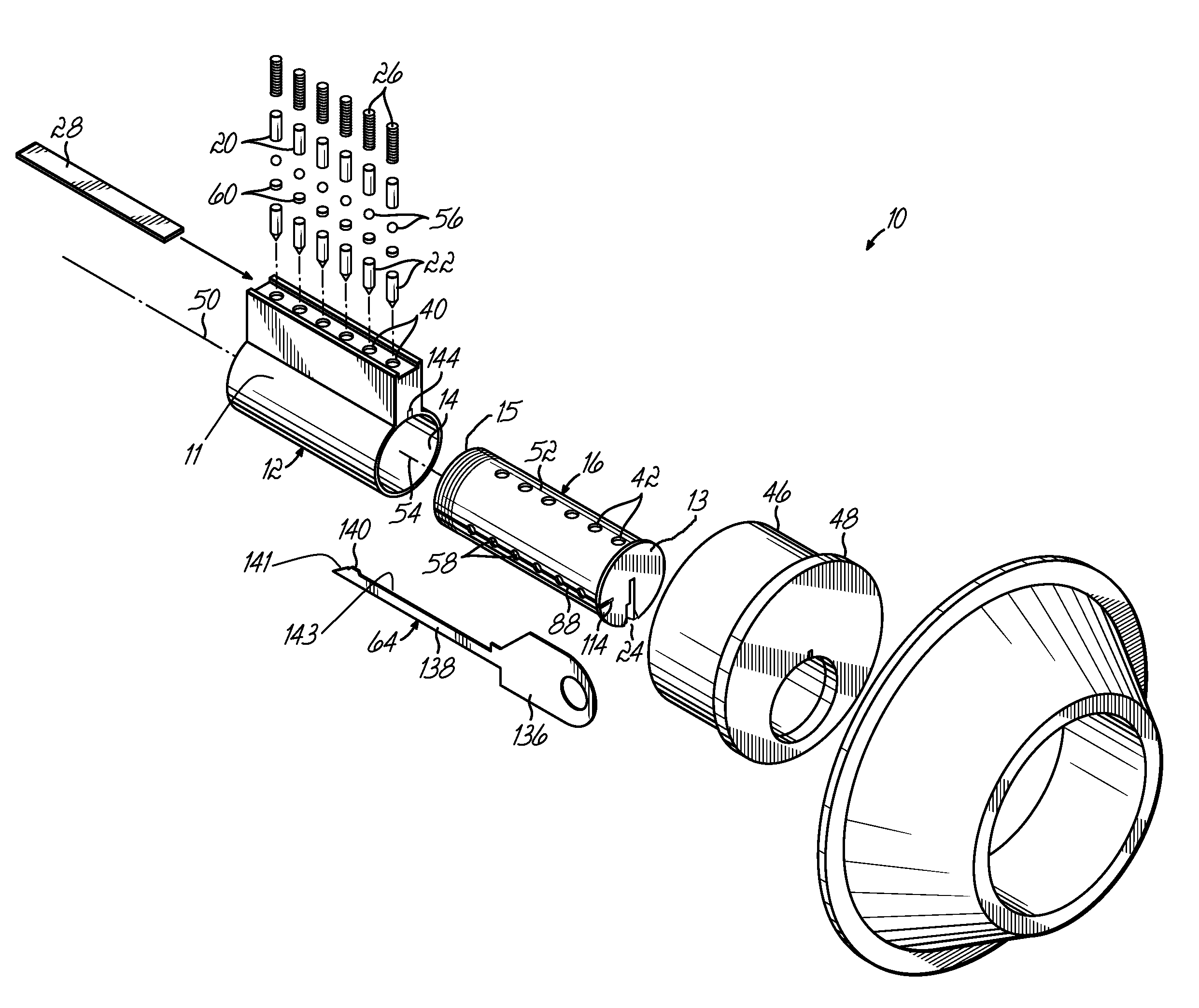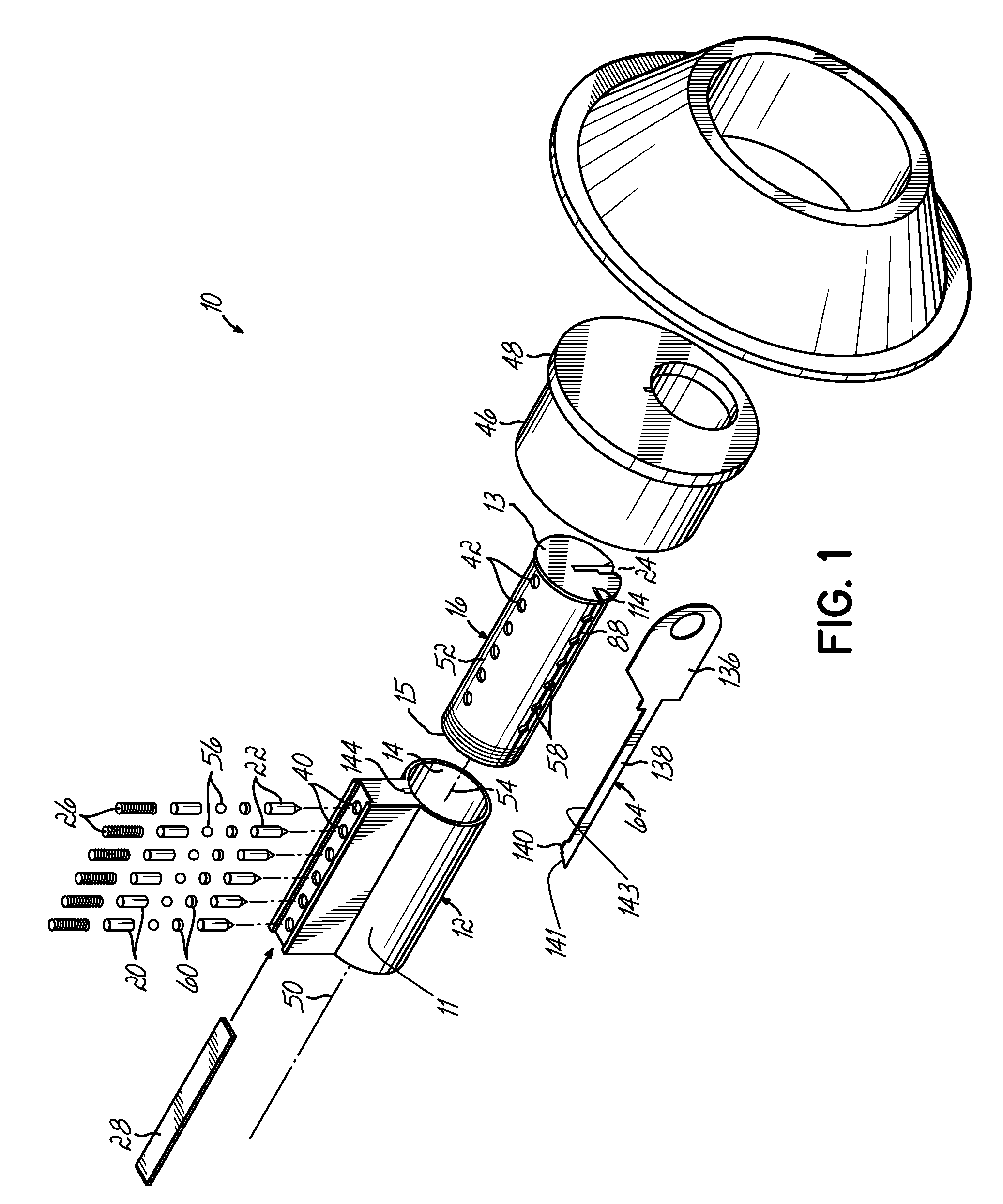Rapid-change lock
a technology of cylinder locks and lock parts, applied in the field of cylinder locks, can solve the problems of affecting the security of the organization, the subsequent occupants or tenants cannot be secure in their persons and property, and the control of one or more, and achieve the effect of rapid change of positioning and without disassembly of the lock assembly
- Summary
- Abstract
- Description
- Claims
- Application Information
AI Technical Summary
Benefits of technology
Problems solved by technology
Method used
Image
Examples
first embodiment
[0138]Referring now to FIGS. 2A-13D, the lock 10 of the present invention is illustrated. This illustrated embodiment of the present invention allows an operator to change the configuration of drivers 20, tumblers 22, and change balls 56 of a lock that operates with a first user key 30, to accept and render operable a second user key 62, and render inoperable the first key 30, without the use of a change tool 64 (see FIG. 1). Thus, the second key 62 is used to change the configuration of drivers 20, tumblers 22, and change balls 56 in the lock 10 in order to foreclose the use of the first key 30, without removal and disassembly of the lock itself. A subset of user keys can be provided wherein the use of each subsequent operating key can reconfigure or re-key the lock 10 to foreclose any previous operating key from operating the lock 10. This progression can be determined by the differing top edge contours 32 of each of the keys. As an operator progresses through using each key of th...
second embodiment
[0173]In another alternative of the invention, the subset of keys can be configured so that each user key in the subset can raise four of the change balls above the shear line 38 of the lock 10 when inserted into the keyway 24. Each user key of the subset of user keys is configured with four raised contour locations 66, wherein no two keys exhibit the same staggered pattern of four raised contour locations 66. The maximum number of keys in the four-raised-contour subset is the same as that number for the two-raised-contour subset of keys described herein before. The four-raised-contour key has an added advantage of reducing the possibility of “incidental keying”. This situation can occur when a lock is opened with a key from outside the subset of keys having one or more contour positions with a slightly different height. The slightly different contour height can cause the centerline of a change ball to be unintentionally raised above the shear line 38 when that key is inserted into ...
third embodiment
[0181]Referring now to FIGS. 23A-28B, wherein like components are referenced by like numbers, an illustrated third embodiment of the present invention is shown comprising at least one memory block associated with a retainer cavity. The memory block 90 is disposed in the plug 16 of the lock 10 and is configured to intersect the change slot 88 and retainer cavities 58. The memory block 90 prevents a user key other than the currently operable user key from being used to alter the driver, tumbler, and change ball configurations in the lock 10 in an unauthorized fashion. The memory block 90 accomplishes this by partially blocking the openings to the retainer cavities 58, so that change balls 56 cannot fit past the opening and into the retainer cavities 58. An authorized user may then insert a change tool 64 to move the memory block 90 away from the change slot 88 and expose the full diameter of the openings of the retainer cavities 58.
[0182]The lock 10 having a memory block 90 is shown i...
PUM
 Login to View More
Login to View More Abstract
Description
Claims
Application Information
 Login to View More
Login to View More - R&D
- Intellectual Property
- Life Sciences
- Materials
- Tech Scout
- Unparalleled Data Quality
- Higher Quality Content
- 60% Fewer Hallucinations
Browse by: Latest US Patents, China's latest patents, Technical Efficacy Thesaurus, Application Domain, Technology Topic, Popular Technical Reports.
© 2025 PatSnap. All rights reserved.Legal|Privacy policy|Modern Slavery Act Transparency Statement|Sitemap|About US| Contact US: help@patsnap.com



